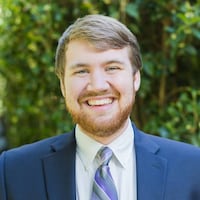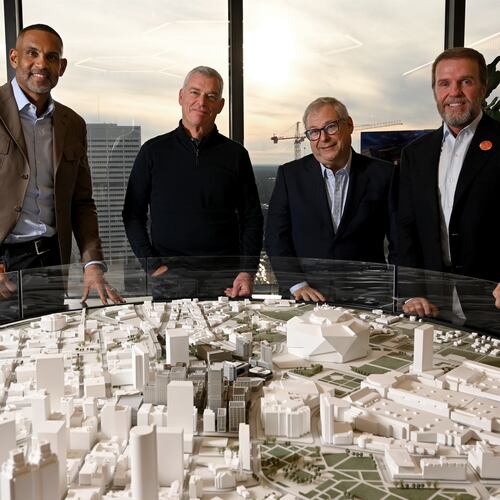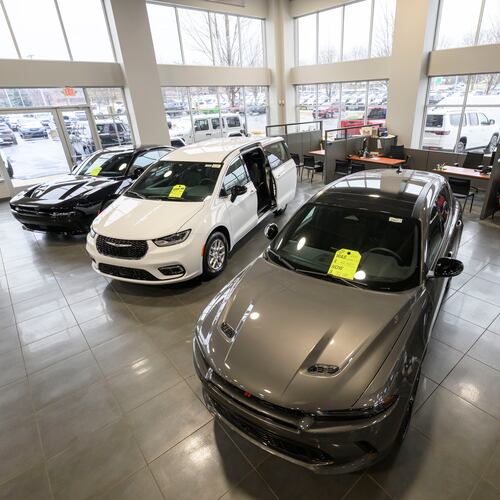On Mitchell Street, a painted advertisement for hotel rooms at 50 to 75 cents a night stands as a reminder of the vibrant past of what was once Atlanta’s Hotel Row.
Steps away, the shuttered Miller’s Rexall drug store on Broad Street graced the cover of a 1999 Paul McCartney album. Soda water that helped popularize fountain drinks was once made in a building on Nelson Street, a few blocks from the pharmacy where the first Coca-Cola was sold.
Credit: Atlanta Journal-Constitution
Credit: Atlanta Journal-Constitution
These and other forgotten buildings in Atlanta’s original brick and stone downtown have their own stories to tell, said Jon Birdsong. He’s betting they have a future.
“This was the entrepreneurial center and capital of the Southeast,” Birdsong said during a recent community tour. “We want to revitalize it back to where it was decades ago.”
Birdsong and his co-investor David Cummings, the serial entrepreneurs behind Atlanta Ventures, recently acquired 53 buildings and several acres of downtown parking lots across 10 blocks that they envision turning it into a hub for startups and entrepreneurs. The buildings and land were once at risk of foreclosure, the remnants of an ambitious but ill-fated effort by a German investor to rehab the century-old structures into a residential and commercial development known as South Downtown.
As reboots go, you might call this South Downtown 3.0. But Birdsong and Cummings have another name: “Startup City.”
Credit: Hyosub Shin/AJC
Credit: Hyosub Shin/AJC
Birdsong, who grew up in Brookhaven, and Cummings, a Tallahassee, Florida product who built a business empire in Atlanta, plan to model the district after their Atlanta Tech Village business incubator in Buckhead, which has been credited with elevating the city’s startup prestige.
There, the investors took a single mid-rise office building in the city’s toniest district and turned it into a hive of brainiacs and disruptors. In South Downtown, they’ve bought something quite different.
Of the 53 buildings formerly owned by Newport RE, some are half-renovated. Others have barely been touched for decades. Most are empty. Downtown, meanwhile, has seen post-pandemic departures of retailers and office tenants amid struggles to change perceptions of crime in the city center.
But Newport’s vision for South Downtown earned them many admirers, Birdsong and Cummings among them. And the duo swooped late last year at the last minute to avoid the properties being sold piece-by-piece from the courthouse steps.
Credit: HYOSUB SHIN / AJC
Credit: HYOSUB SHIN / AJC
While some of the hurdles they have to overcome are daunting, the new owners aim to take their time to realize their vision and finish what Newport started, albeit with some differences.
In an interview, Cummings said the team envisions restoring street front retail, with restaurants and bars. Apartments will also be part of the area’s future, though that might be the domain of other partners.
“For most of downtown, housing is the main opportunity. I think for South Downtown, it’s housing plus startup office space,” he said.
The South Downtown portfolio lies just south and east of Centennial Yards, the 50-acre mini-city being built over the parking lots and rail lines in the shadow of Mercedes-Benz Stadium. Centennial Yards is expected to include thousands of residences, office space, hotels, retail and a huge entertainment district. The two projects, boosters say, are primed to dramatically change the trajectory of downtown.
Since buying the South Downtown properties at an undisclosed price, which Cummings described as “a heavy discount,” Atlanta Ventures has offered walking tours of South Downtown’s streets to show those curious why they were motivated to take over the massive endeavor. For many tour-goers, it was the opportunity to peer into a time capsule of Atlanta’s past while daydreaming about its future.
“I’m excited to see this cool collection of buildings and what can become of them,” Luke Darch, a realtor who lives in Inman Park, said before a March tour. “It’s the heartbeat of Atlanta right here.”
Credit: HYOSUB SHIN / AJC
Credit: HYOSUB SHIN / AJC
Community through commerce
The streets around the Five Points MARTA station were once Atlanta’s financial district, abuzz with bankers and merchants.
Rich’s department stores and C&S bank both occupied longtime headquarters in South Downtown, commanding commerce to flow through the area’s two intercity rail terminals. Atlanta Union Station and Terminal Station ushered thousands of commuters into the district to buy and sell their wares or stay in one of the area’s many hotels.
“Back in 1905, people would get off the Terminal Station, walk through Hotel Row and then there’d be 250 merchants here selling things,” Birdsong said.
That past has faded.
Historic plaques and sun-washed adverts are among the few signs of the buildings’ former glory. A few colorful canopies dot Broad Street, a relic from the 1996 Summer Olympic Games when vendors were swarmed by international guests.
Credit: Atlanta Journal-Constitution
Credit: Atlanta Journal-Constitution
The two rail stations were razed decades ago and replaced with a federal courthouse and parking lots — a common sight across South Downtown. Aaron Loggins, who moved to Atlanta from Texas two years ago, lamented how century-old buildings that formed the tapestry of cities like Atlanta were torn down as automobile travel took over the nation.
“They came in and destroyed beautiful historic buildings to put parking lots there because there wasn’t enough parking,” he said, while walking around a nearly empty stretch of asphalt in view of the Garnett MARTA station. “It destroyed the soul of the city, and it ended up like this.”
Pushback against Atlanta’s sprawl and car-centric design has attracted a new wave of urbanists to the city’s core, which Birdsong and Cummings see as a potential client base for their vision. While their Buckhead incubator appeals to technology startups, they said South Downtown will cater to creatives and a wider variety of entrepreneurs.
Cummings compared the broad Startup City plan to a college campus — not just for its walkability, but for its specialized ecosystem.
“Where college campuses have the different specialties in different academic buildings, our specialties are grouping different entrepreneurs together in whatever areas they are innovating in,” he said.
Credit: HYOSUB SHIN / AJC
Credit: HYOSUB SHIN / AJC
Downtown momentum
Buying the South Downtown portfolio was one of Atlanta’s most complicated real estate transactions in recent years. It all started with just a few text messages.
Credit: Atlanta Journal-Constitution
Credit: Atlanta Journal-Constitution
In July, Newport announced that it would sell all its holdings to Braden Fellman Group, an Atlanta developer known for revitalizing industrial properties, in a bid to avoid foreclosure. But that deal fell through.
The roster of buildings and parking lots was tied up in seven different loans that were all facing foreclosure. The largest building, the former 300,000-square foot 222 Mitchell that was formerly a C&S bank building, has been locked in a court battle over $7 million in unpaid invoices for contract work.
Cummings texted Birdsong and some other colleagues with a lofty idea.
“What would we do with 10 city blocks, 15 acres and 53 buildings?” he asked Oct. 19.
Lawrence “LG” Gellerstedt, Atlanta market leader at commercial real estate firm Foundry Commercial, who brokered the deal on behalf of Atlanta Ventures, said Cummings spent 10 hours the next day touring several of the buildings. Gellerstedt said it was a sprint to keep the entire portfolio under one ownership group.
“If it had gotten split apart, it’s a 10-year or more setback for downtown,” he said.
Unlike Newport, which used a lot of debt to buy its properties, Atlanta Ventures used equity. Cummings said that gives them a long leash to deliver their vision. That’s allowed the new owners to start taking stock of what they bought and figure out how to use each building.
Credit: HYOSUB SHIN / AJC
Credit: HYOSUB SHIN / AJC
Since taking over, they’ve already opened up Atlanta Tech Village Mason’s at 170 Mitchell St., which used to house Newport’s offices. It’s a co-working space with 50 entrepreneurs, and the Atlanta Ventures team aims to convert the 115-year-old Sylvan hotel into a larger incubator more akin to the Buckhead location.
Despite its recent turmoil, South Downtown is trying to leverage a sense of growing momentum throughout Atlanta’s core.
The area’s MARTA stations are slated for renovations. A city-backed conversion of the 40-plus-story 2 Peachtree Street office building into apartments is moving forward and several efforts are underway to get more people to live downtown.
The biggest downtown project of them all — Centennial Yards, the $5 billion redevelopment of the sea of parking lots and rail lines known as the Gulch — recently announced it would break ground on an entertainment district this summer and aims to have it activated in time for the 2026 World Cup, which includes Atlanta as a host city.
Brian McGowan, the head of Centennial Yards, said shifting South Downtown’s focus to startups is a great addition, especially given the proximity to several universities.
“There’s three major college campuses within a scooter’s ride of Centennial Yards,” he said. “... When these guys announced (they acquired the South Downtown portfolio), we were like, ‘Oh this is fantastic to have. They’re a great thing for us to accelerate that idea.’”
But the development comes at a time when other parts of downtown are losing businesses. Cummings and Birdsong think that as more entrepreneurs come to South Downtown, they will become future office tenants as their businesses grow and could attract other professionals like lawyers and accountants.
‘The onus is on us’
Before its financing fell apart, Newport was preparing to break ground on its first new construction: a high-rise apartment building.
Cummings said South Downtown should have people living in it, but his plans do not include skyscrapers. Instead, a handful of buildings could be converted into condos and apartments, and any new construction will likely be mid-rises, which he called “gentle density.”
Longtime South Downtown resident Robyn Jackson said he and his neighbors have been clamoring for decades for more nearby housing options. But he said the core root of his neighborhood’s problems is simply a lack of people.
“The more people we get down here, the better — whether it’s from incubators or residents,” he said. “Cities need people. Neighborhoods need people.”
Cummings agrees and thinks that could help deter crime in the area.
“If there’s energy and people and activity... then people aren’t going to be as likely to come into the neighborhood for whatever purpose they might have,” he said.
Credit: HYOSUB SHIN / AJC
Credit: HYOSUB SHIN / AJC
New construction, which will require partnering with other development firms, won’t be anytime soon.
“It could be five years, six years or it could be 40 years,” Birdsong said. “It just depends on markets and how fast we want to go and can go.”
About a tenth of South Downtown’s portfolio is occupied with tenants. For now, the focus is squarely on Hotel Row and filling it with restaurant tenants, despite downtown’s struggling retail market. The district’s first restaurant, Thai eatery Tyde Tate Kitchen, was joined by Spiller Park coffee in early April.
“The onus is on us. It’s a partnership,” said April Stammel, a former Newport executive hired by Atlanta Ventures to stay with the project. “Any tenant that’s coming to Hotel Row now, we are linking arms and we’re saying we’re doing this together.”
Cummings said South Downtown won’t resemble its heyday by 2026 when the World Cup comes, but it acts as a deadline to introduce scores of new people to the long-overlooked neighborhood.
“The World Cup isn’t the be-all end-all,” Cummings said. “But the World Cup is nice in that it is a great hard-and-fast date to be our launch party for phase one of the neighborhood.”
— Staff writer Mirtha Donastorg contributed to this report.
About the Author
Keep Reading
The Latest
Featured








